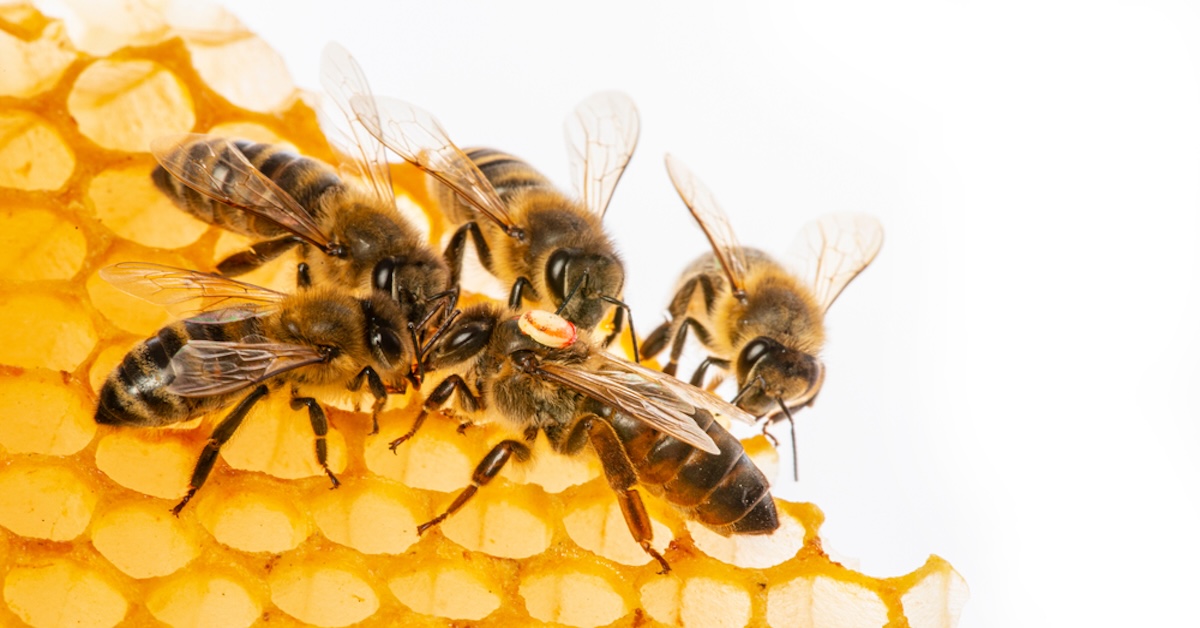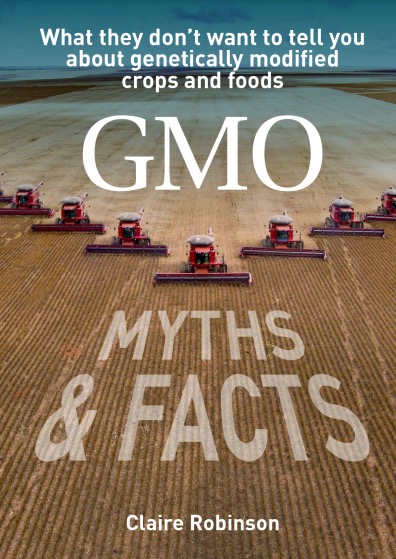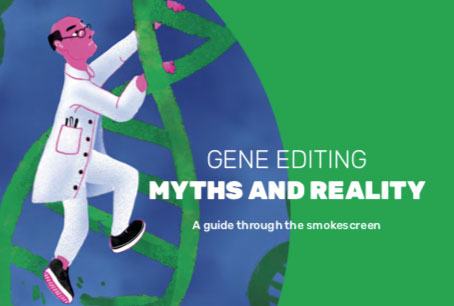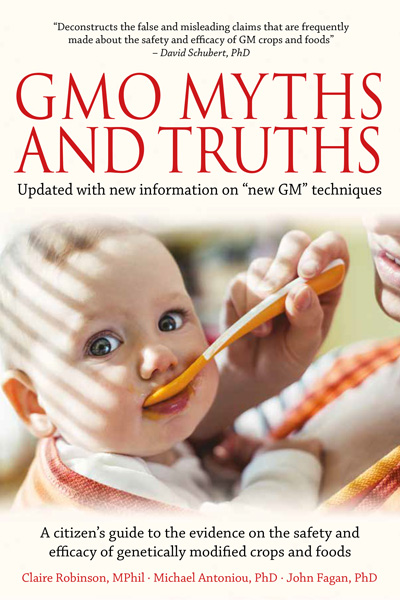 Product is intended to “enable honeybee colonies to produce brood in the absence of floral pollen”. Report: Claire Robinson and Prof Michael Antoniou
Product is intended to “enable honeybee colonies to produce brood in the absence of floral pollen”. Report: Claire Robinson and Prof Michael Antoniou
Scientists have developed a food supplement that “could help save honeybees from devastating declines”, according to a press release from the University of Oxford, where the lead researcher is based. The scientists used transgenesis (foreign gene insertion) augmented with gene editing to produce a strain of yeast that could be ground to a powder and used as a food supplement for bees. The food supplement contains six essential sterols – types of fat – that are found in pollen, the usual main food source for bees.
The resulting bee food supplement is being promoted as “a nutritionally complete diet" that “boosted reproduction up to 15-fold”. The press release says, “Unlike commercial substitutes that lack key nutrients, this supplement mimics natural pollen’s sterol profile, giving bees the equivalent of a balanced diet.”
The researchers write: “The use of this method to incorporate sterol supplements into pollen substitutes will enable honeybee colonies to produce brood in the absence of floral pollen. Optimised diets created using this yeast strain could also reduce competition between bee species for access to natural floral resources and stem the decline in wild bee populations.”
The yeast-based bee food supplement, described in a study by Elynor Moore et al, is touted as a triumph of genetic engineering. At face value it seems to be a nutritional step forward from the supplemental feeds already used by some beekeepers. However, it carries its own risks. These include perpetuating an unsustainable agricultural model, as well as potentially creating additional problems of its own due to the inherent dangers stemming from the large-scale biochemical changes arising from the GM process – as detailed below.
Extreme genetic engineering
Moore et al published their findings in the journal Nature. In their paper, they identify the cause of bee colony decline as “pollen starvation as a result of agricultural intensification and climate change”. For “agricultural intensification”, read pesticides, as well as the destruction of biodiversity by monoculture farming.
The researchers explain that beekeepers’ solution over the past 40 years has been to feed artificial pollen substitutes when natural forage is insufficient or when bees are kept at high densities: “However, commercially available pollen substitutes composed of protein flour, sugars and oils are not nutritionally complete feeds for honeybees. Such diets are missing essential sterols found in floral pollen that are necessary for colony health and growth.”
To fill the nutrition gap, the researchers undertook a large-scale genetic engineering of yeast. Using CRISPR-based gene editing as an aid, they introduced a total of 18 genetic modification events, consisting of a combination of gene disruptions and inserted foreign transgenes sourced from diverse organisms, including the single cell organism Tetrahymena thermophilia, algae, potato, and tomato.
This extreme feat of genetic engineering – worthy of the name “synthetic biology” due to the completely novel biochemical pathways engineered into the yeast – resulted in the production in the yeast of the six sterols found in pollen. The GM yeast product was then dried, ground to a powder, and fed to bees by adding it to a base diet, over a test period of three months. The trial was held in a “semi-field” situation, where hives were set up in a closed glasshouse.
The result was that colonies fed with the sterol-containing yeast supplement added to their diet reared brood for significantly longer than the controls fed diets without the supplement. They also reared up to 15 times more larvae to the viable pupal stage, compared with controls.
The press release announcing the findings concludes, “This new technology could also be used to develop dietary supplements for other pollinators or farmed insects, opening new avenues for sustainable agriculture.”
Win-win solution – or a sticking plaster for unsustainable agriculture?
The GM yeast-derived food supplement is being promoted as a win-win solution for bees, beekeepers, and farmers who depend on bees to pollinate their crops. After all, some beekeepers have been giving bees supplemental food during pollen-scarce periods of the year for decades. This GM yeast-derived food is specifically designed to have a superior and more nature-similar nutrition profile. Surely that’s good news all around?
Maybe not. Closer examination reveals several reasons for scepticism of this approach, ranging from “big picture” fails to technical knowledge gaps and questions of who controls the technology.
1. Delaying action on pesticides and biodiversity
Let’s assume for a minute that the technology works as intended and isn’t dangerous to the bees (though we don’t yet know that – see point 4 below).
The researchers’ words – “The use of this method to incorporate sterol supplements into pollen substitutes will enable honeybee colonies to produce brood in the absence of floral pollen” – should ring alarm bells.
This technology, aimed at solving the problem of decline in bee populations and health, could end up perpetuating it. It’s well known that pesticide use in agriculture is a major factor in bee decline. And the loss of biodiversity in the form of pollen- and nectar-bearing plants impacts pollinators like bees and butterflies – as well as people’s mental health.
Are we happy to accept a biodiversity-poor environment in which only the obviously economically valuable insects, such as honeybees, must be artificially supported with a lab-created supplement so that they can continue to serve humans? What about the vast majority of insects – including wild bees, that won't be fed with the supplement? And what about the animals – like birds and bats – that feed on those insects? Do we accept their continued decline?
Additionally, honeybees have often been called the new canaries in the coal mine because their sensitivity to certain environmental stressors and their close monitoring by beekeepers can alert us at an earlier stage to problems developing in the environment that may also be impacting a wider array of pollinators and other wildlife, and which could even have implications for human health and wellbeing. So a techno-fix that is aimed specifically at artificially supporting honeybees in the face of such pressures could be compared to providing the proverbial canary in the coal mine with its own oxygen supply, thereby preventing the alarm from being raised. And alarmed beekeepers are also a source of political pressure for environmental improvements.
Viewed in this light, a GM-derived “better supplement” for nutrient-starved bees is no more sustainable than the notion of feeding the hungry people of the world (who are too poor to buy the food that is available in every marketplace) with genetically engineered “Golden Rice”. As Nobel Laureate Joshua Lederberg said: “Our imperfect solutions aggravate every problem”.[1]
A more systemic solution would be to ensure that nutrition-starved insects – like people – have access to a locally produced diverse and nutritious diet. And a greater availability locally of pesticide-free wildflowers, for instance, would provide not just many insect pollinators with food but their seeds could be an important food source for birds and small mammals, among other ecosystem benefits.
Supplements, on the other hand, should be used only as limited and short-term stopgaps at naturally pollen-deprived times of the year. They should only be used at other times of the year pending the implementation of more sustainable and holistic solutions.
2. Monetising the problem instead of solving it
When a problem is monetised, there’s a disincentive to solve it – because money is being made from the continuance of the problem. This GM-derived food supplement for bees monetises a manmade problem (pesticide poisoning and poor biodiversity) by providing a patented proprietary technological “solution” that farmers and beekeepers will need to pay for on an ongoing basis.
The product has to be made in bioreactors, an energy- and resource-hungry system, and will be priced accordingly. Beekeepers and farmers will become more dependent on corporations and potentially expensive products.
More broadly, this techno-solution means that there’s a built-in economic disincentive for the problem of “bee starvation” to be fixed through less costly farmer/beekeeper-controlled systemic approaches, such as decreasing pesticide use and planting insect-friendly areas. In the current climate of agricultural over-production and consequent low prices paid to farmers, it makes no sense to continue to avoid these holistic and genuinely win-win approaches. Of course, farmers will have to be supported to implement them.
3. Risk of impacting bees’ natural behaviours
Better nutrition through supplementing feed can improve bees’ natural foraging behaviour. However, some scientists warn that supplementation can also replace natural behaviours that bees show during pollen and nectar shortage periods, and that help them survive in difficult circumstances: “Thus, supplemental feeding may mask or compound factors that impact colony health.”
So if society comes to over-rely on feeding “improved” supplements, to the exclusion of systemic solutions to improve the environment, such as those mentioned above (point 2), several questions arise:
* Will this impact bees’ natural behaviours, such as foraging and communication?
* Is there a danger that bees will become dependent on human-provided supplements to an extent that they lose the ability to survive without them?
* In the absence of incentives to create healthier environments, how will other pollinators, less well known to humans than honeybees and superficially less economically important, fare in the pollen- and nectar-poor and poisoned environment facilitated by improved supplemental feeding of bees?
4. Longer-term risks to bees haven’t been ruled out
To the researchers’ credit, they state in their paper that any conclusions drawn from their three-month study are necessarily limited. They write: “Understanding the full impact on the health and performance of honeybees fed with [the supplement] would require a long-term field study with standard size colonies.” But whether such studies will be done, given the commercial drive behind such products, is doubtful.
That said, further investigations could and should be done immediately as a first step in a safety evaluation, before this product reaches the market. Insofar as we can tell from the Moore et al paper, the researchers have not tested their product for unexpected toxins produced by the GM yeast.
In this respect it’s instructive to draw a comparison with the manufacturing process for human-like insulin, which is derived from GM bacteria and is used for treating diabetics. The product is put through a thorough multi-step purification process, meaning it does not contain any unintended contaminants. In contrast, the sterols mixture that Moore and colleagues produced is not purified but is simply taken in its whole form, dried, ground up, and fed to the bees. So there is no assurance that the product does not contain substances that could be toxic to bees over the longer term.
This raises the question of unexpected toxins produced by GM microorganisms resulting from an alteration of core biochemical pathways. These can pose a real food and feed safety threat, as shown by the tragic episode in the 1980s when over 1500 people were sickened and 37 died after consuming a GM bacteria-produced version of the food supplement L-tryptophan. The toxicity turned out to be due to unexpected contaminants resulting from unpredictably disturbed biochemistry of the GM bacteria. The suspected toxins that caused the problem were present only at around 0.01% of the product.
With this cautionary tale in mind, Moore and colleagues should conduct an analysis of their bee sterol product via untargeted proteomics and metabolomics to ensure that it does not contain unexpected toxins that could have adverse effects when fed over a long-term period.
There’s also the question of nutritional completeness. We know that traditional bee food supplements are notoriously incomplete, in the sense that they only provide a few of the nutrients that bees need to stay healthy and productive. We also know from a recent study that wild bees’ natural diet is extremely complex, as they strategically visit different flowers to balance their dietary intake at different points in colony development and at different times of year, leading researchers to conclude that bees’ nutrient needs are not remotely “one-size-fits-all”. In the light of this, one expert not involved in the study commented, “Bees show a kind of collective intelligence. Studies like this show how specialised and vulnerable bees are. We need to protect both bees and their ecosystems”.
Moore and colleagues have identified six sterols essential to honeybees and produced versions of them from GM yeast. But we shouldn’t be lulled into a false sense of security that this is a complete food, because we know too little about which nutrients bees need in the long term. And just as even the best vitamin supplements won’t keep a human healthy and vibrant if they are their only or main food, so any over-reliance on this GM-derived supplement could, over time, further weaken already stressed bee colonies.
“Pseudopollen”
A caution on the question of the GM-derived supplement's nutritional quality comes from Dr Robert Mann, a biochemist who served on New Zealand’s Toxic Substances Board advising successive government ministers of health on poisons. He was an outspoken public interest advocate regarding the L-tryptophan scandal and has consistently warned about the dangers of the common regulatory assumption that GM foods are “equivalent” to natural foods and therefore just as safe and nutritious. He’s also been a beekeeper for the past 35 years. Commenting on the GM-derived bee food supplement, he told GMWatch, “I deplore this pseudopollen. Pollen is a remarkably complete food – not only for bee larvae but also for humans. A sketchy partial mixture will not substitute for it.”
In conclusion, the new bee food supplement may at best provide a sticking plaster solution to the immediate crisis facing bees. But unless we address the root causes of bee and general biodiversity decline, we will dig ourselves further into the hole we find ourselves in.
The new study:
Moore E et al (2025). Engineered yeast provides rare but essential pollen sterols for honeybees. Nature, 20 Aug. https://www.nature.com/articles/s41586-025-09431-y#Sec5
Notes
1. Lederberg J: Orthobiosis: the perfection of man. In The Place of Value in a World of Facts. Edited by Nilsson S, Tiselius A. John Wiley & Sons; 1970:29-58. Cited in Heinemann JA, Hiscox TC (2022). Rethinking the drivers of biotechnologies: a paradigm for holistic climate change solutions. Current Opinion in Environmental Sustainability 59. https://www.sciencedirect.com/science/article/pii/S1877343522000744
Image: Shutterstock (licensed purchase)










